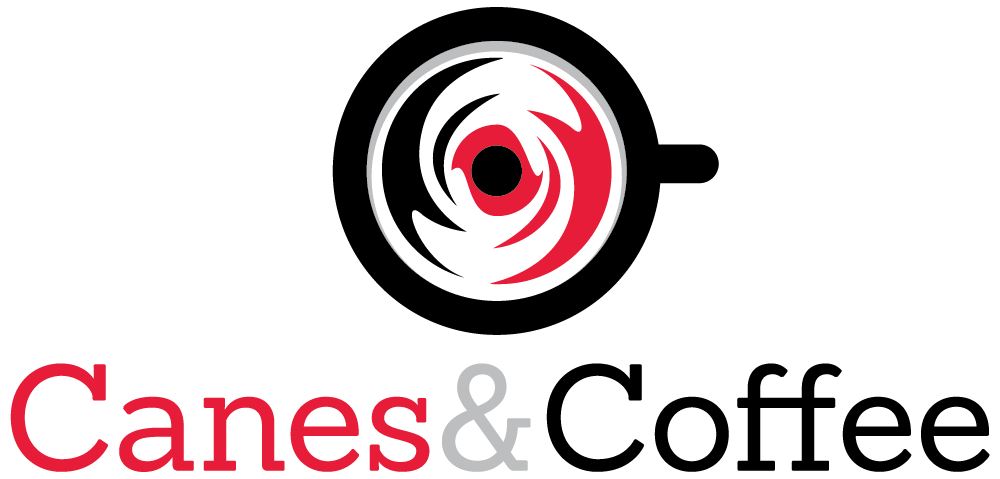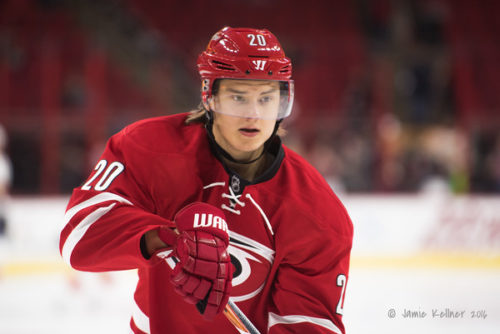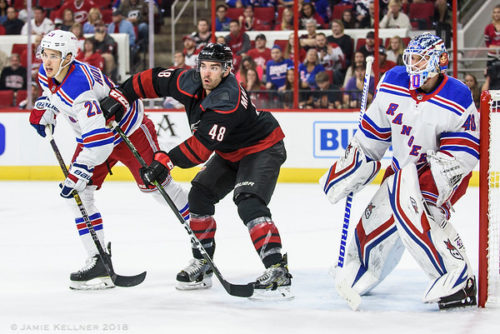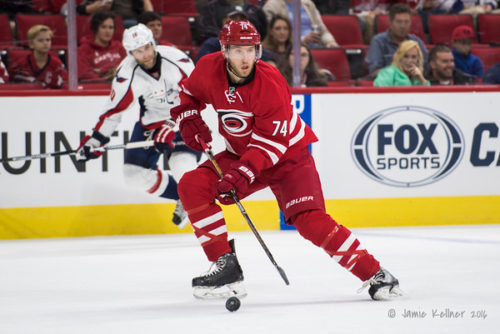With a few days away from writing around Christmas and a decent number of games, today’s Daily Cup of Joe is the semi-regular batch of notes that have not made it into other articles (at least in detail).
Justin Faulk with Klas Dahlbeck
I have been complementary of Klas Dahlbeck’s play on multiple occasions. Initially, I was impressed by his ability to hop into the lineup cold and be mostly unnoticeable in a good way just playing steady hockey without any glaring problems despite the long layoffs between games. More recently, he seems to have at least temporarily won himself a regular slot in the lineup next to Justin Faulk.
The sample size with Dahlbeck is small as he has only played in nine games, but the results are impressive. Most importantly, the Hurricanes are 5-2-2 with Dahlbeck in the lineup. In December, the Hurricanes are 4-0-1 with Dahlbeck in the lineup, and Dahlbeck is plus 4 in those 5 games.
Maybe more significant than Dahlbeck’s own statistics is the fact that he seems to have early chemistry with Justin Faulk. Faulk’s defensive game has been quieter in recent games next to Dahlbeck, and Faulk has also collected two goals and two assists in his past three games next to Dahlbeck.
Both Dahlbeck and Faulk are worth keeping an eye on right now. Could Dahlbeck somewhat surprisingly be the player who helps solidify the blue line in terms of chemistry and complementary pairings? We have already seen Noah Hanifin’s offensive game take a step up since being paired with Trevor van Riemsdyk. If Dahlbeck can do the same for Faulk on a longer-term basis at the same time that Jaccob Slavin and Brett Pesce rebound, the Hurricanes could see the blue that is supposed to be a consistent advantage at some point in the future arrive in time for a 2017-18 playoff push.
Haydn Fleury
Despite currently being pushed out of the lineup, Haydn Fleury has had a successful start to his NHL career and has proven that he is capable of playing at the NHL level. But if Dahlbeck sticks as the #6 defenseman, it might make sense to get Fleury a stint or two at the AHL level to stay sharp. At 21 years old, Fleury can still benefit from regular ice time versus time in the press box. Fleury is waiver exempt, so he can come and go freely between the NHL and AHL without risk of being lost to another team. That situation makes it possible to get Fleury some work at the AHL level but still be available at any point he is needed at the NHL level. That situation also makes it possible to reward an AHL defenseman or two with a nice short-term pay boost playing at an NHL salary even if it is as a healthy scratch. Fleury has only been out of the NHL lineup for a handful of games, so there is no incredibly rush, but if Fleury seems destined for an extended run as a healthy scratch, best is to keep him active even if it is at the AHL level.
Looking forward to the trade deadline
With the team winning right now, there is obviously no urgency to do a deal to improve the team. And come late February, it is not impossible that Francis assesses options and makes the decision that given the options available via trade, prices for those players and who the Hurricanes have in the lineup that nothing really makes sense. But at the same time, my hunch is that Francis will spend a modest amount of futures to boost the team’s playoff prospects if the team is still legitimately in the playoff hunt come late February.
When I look at the lineup and slot players, I think the greatest opportunity for improvement externally could prove to be the center slot occupied by Derek Ryan and the left wing slot occupied by Brock McGinn.
First off, it is important to note that both Ryan and McGinn are playing well. Ryan’s 20 points in 36 games makes for a respectable 46-point pace. The offensive ability which is the strength of Ryan’s game is providing depth scoring on par with normal third line center production. But depending on options, I still think the potential could be there to add a higher-end center to the mix, ideally with the ability to drive a higher-end scoring line.
As for McGinn, he too is playing well. Right now, I view McGinn as being the #9 forward but a very good one so far in 2017-18. McGinn brings every shift intensity and consistency and a bit of sandpaper to a lineup that is a little bit light in that regard. Further, McGinn’s 35-point pace is pretty good especially when considering his limited ice time and lack of power play ice time. As with Ryan, I do think the potential is there to better the team with a wing with more scoring upside.
I am torn on the fourth line and its role
Right now, nothing has me more on the fence in terms of ratings right now. In terms of what the line was designed to do, I think the Hurricanes’ current fourth line meets expectations. Coach Bill Peters feels comfortable enough with Nordstrom/Kruger/Jooris or Di Giuseppe that he uses them regularly in the all-important shift coming out of the power play. And the fourth line generally holds its own defensively.
But despite the eye test being favorable, two things jump out at me about the fourth line. First is that the set of four players have only six goals in 104 games. That makes for a pace of just under five per player (or 15 as a line) projected over 82 games. That would be down from the 21 goals that Nordstrom/McClement/Stalberg netted in the 2016-17 season despite playing less than 82 games.
The second thing that jumps out at me about the fourth line is the team’s struggles on the penalty kill. Worth noting is that the penalty kill has been better of late and just might be rounding into form. But through 36 games, the penalty kill is 26th out of 31 teams in the NHL, and at least in terms of simple goals per ice time metrics, neither Marcus Kruger or Joakim Nordstrom have been great. Consider that on the penalty kill, opponents average a goal for every 4.0 minutes that Kruger is on the ice and a goal for every 5.9 minutes of penalty kill ice time for Nordstrom. Those numbers do not compare favorably the the Hurricanes other forward penalty killers. Jordan Staal clocks in at a goal for every 10.7 minutes of penalty kill ice time, Brock McGinn at a goal per 17.0 minutes of penalty kill ice time and Derek Ryan at a goal for every 8.5 minutes of penalty kill ice time. Fourth-liner Josh Jooris is better with only one goal against in just over 20 minutes of penalty kill ice time, but he has logged significantly fewer minutes than Kruger and Nordstrom.
For the fourth line to be more of a true statistical success, one of two things need to happen. Either the group needs to score more at even strength to boost its offensive contribution and at the same time decrease the scoring deficit when the fourth line is on the ice, or otherwise the group needs to be elite in terms of penalty killing to help the Hurricanes gain a special teams advantage.
The penalty kill has been better of late, so perhaps some patience is in order with wholesale personnel changes over the offseason, but part of me continues to think that Peters might be too fixated on forcing the issue with a formula that he thought would work at the expense of being more creative given the players at his disposal.
Measured by goals allowed per ice time on the penalty kill, all of Jordan Staal (10.7 minutes per goal allowed), Brock McGinn (17.0), Derek Ryan (8.5) and Josh Jooris (20.9) have outperformed Marcus Kruger (4.0) and Joakim Nordstrom (5.9) by a wide margin. Elias Lindholm’s 6.5 makes five forward penalty killers who have been more successful than Kruger and Nordstrom thus far in 2017-18.
Part of me thinks that the team might fare better with a fourth line centered by Lucas Wallmark and possibly even with a scoring wing on one side with more penalty kill time being given to players like Jooris, Ryan and McGinn over Kruger and Nordstrom. Interestingly, Peters has shifted somewhat in this direction with success in the past few games simply by giving even more penalty kill ice time to Staal over Kruger.
Is it possible to actually improve the penalty kill by giving more minutes to Jooris, Ryan and McGinn and simultaneously improve its scoring by adding a player like Wallmark to the mix to boost scoring? At a minimum, I would be trying out the penalty kill half of the equation and also be quick to test the scoring part of the equation if an injury opens up another forward slot.
What say you Canes fans?
1) Do you think Dahlbeck/Faulk has staying power, or is it just a combination that is working short-term and is likely to eventually re-add Fleury? Would you consider keeping Fleury sharp with an AHL stint?
2) What are your thoughts on the fourth line? Is it really as good as everyone seems to think? Or do the underlying statistics for the penalty kill and 5-on-5 scoring suggest otherwise?
Go Canes!




1) My thoughts are that Dahlbeck is a short-term improvement. The sample size is extremely small–so I find it difficult to credit Dahlbeck with Faulk’s recent production. It is much more likely to be coincidental. I expect Fleury to be re-inserted, maybe as soon as tonight. Although, the one stat that jumps out is giveaways. Dahlbeck is significantly less likely to give the puck away. With Faulk becoming more aggressive, Dahlbeck’s low risk style could continue to make more sense.
2) I have been having some of the same thoughts. Though, I will admit the PK statistics you cite for Kruger and Nordstrom are surprising. I did not know they had been struggling that much more than others. As far as scoring potential, it seems a fourth line shake up is in order. My preferred action would be a call-up of Zykov. Lindholm could get some time at center. The lines could be TSA, Skinner/Rask/Zykov, McGinn/Lindholm/Williams. Ryan could move to RW on the fourth line to give it more scoring punch. That doesn’t change up the PK, but as you mentioned, it may be finding it old form at the moment.
On your other point about the trade deadline. I think the conventional wisdom is becoming ossified. I was listening to NHL radio yesterday and the analysts discussed the Senators and Hurricanes in sequence. They mentioned how the Ottawa’s move to bring in Duchene was not working. One analyst specifically said bringing a player in often causes more negative disruption (because of different playing style, different passing ability, etc.) than positive improvement. Then within 60 seconds the same analyst was stating that Carolina should try to add another forward. Several of the C&C regulars have pointed out that the slow starts under BP indicate that Peters is a systems coach. Given that the players in Charlotte are demonstrating strong potential and are familiar with the system, I am not sure a trade for anything less than an elite scorer would make sense.
My biggest concern about the 4th line is Kruger, who’s not as effective as advertised, IMO!
I’m just hoping our new owner (when officially confirmed), will make things happen, ie. OPEN THE PURSE-STRINGS. If you folks who believe it’s PK who’s cheap (not RF)…THEN we might see some changes, BUT…I’M NOT GONNA HOLD MY BREATH.
Kruger is an ‘average’ at best 4th line center. He isn’t worth the salary at this point of his contract, but GMRF likely knew this going in and simply wanted a proven veteran, which is not a bad thing either. I do agree we need more offense from the 4th line, but also the 3rd line as well.
That said, I think Derek Ryan should be our 4th line center. This would open up a 3C spot. To fill this, we should first look to make a trade for a top 6 forward with scoring ability and grit (Kane, Hoffmann types) as puckgod mentioned in another thread. Depending on the player(s) we send out in the deal, 3C can then be filled by either Walmark/Zykov, or by dropping Lindholm or Rask to 3C.
Well, live-free and ct, you’re getting a partial wish: Wallmark was just called up. Wonder if he plays tonight and how the lines get affected.
I would also be remiss if I did not say that, our current-fine-play-that’s-getting-results notwithstanding, this next stretch of 9 games is daunting: PIT, @STL, WAS, @PIT, @ BOS, @TBL, @WAS, WAS, CGY. All are playoff teams or on the cusp. To me, anything less than 9 points puts the season at risk; 12+ points means we have found our game and are for real. The time for loose play is over.
Dmilleravid this upcoming stretch is indeed daunting. And crucial. Would like to see Wallmark play tonight!
I heard on NHL radio yesterday that Carolina has had most difficult schedule up to holiday break. So the next stretch is more of the same–except many are within conference/division.
I am also hoping to see Wallmark. And agree with tj’s comment below that he would be best used on a skill line–maybe with Skinner and Lindholm. In any event, we will see how well the team plays now that they have fought their way back into contention.
Dahlbeck has staying power. Keep him fresh by resting him on second night of back-to-backs.
Get Fleury more playing time in the AHL. I felt from the start of camp – with the placement of his locker to group assignments – that he was anointed rather than victorious from outplaying the rest of the players in camp. He will be a solid player but needs improvement in all areas of his game, and that requires playing time.
The fourth line statistics surprise me, I didn’t pick up on the poor PK stats watching the games. We need scoring lines to be fresh coming off the PK and that requires the fourth line to kill penalties.
Wallmark and Foegele deserve chances if the current guys aren’t getting it done. Both are scoring consistently and over +10 in plus/minus. Zykov is scoring goals but is still -7 overall, not sure if that is due to defensive struggles personally or simply line combinations, but to be a fourth liner requires good defensive play first.
Nice, thoughtful article, Matt.
As I was in the arena watching the Habs game I was thinking about the low-scoring nature of the 4th line. I am hoping Wallmark is given a full opportunity to show what he can do as a center. Sliding Ryan down to the 4th line and having Wallmark center some high-scoring wings as he does in Charlotte would be my ideal placement for him (as opposed to centering the 4th) but that is more wishful thinking on my part than anything else.
Foegele up for a tryout on the left in lieu of McGinn would be an interesting experiment, but I don’t see RF or Peters experimenting right now. And they certainly won’t change “what’s working” even if improvements might come from it.
Dahlbeck did not have a strong game against MTL – but, yes, if he is proving his worth on the left side of Fleury, sending Haydn down for more ice time in Charlotte is the right thing to do. But I really think Haydn should stay up and play at this level.
1) Dahlbeck certainly has staying power. Don’t fix what isn’t broken on the D-pairings, and I totally agree Fleury should be re-assigned to keep his game developing. Let Kitchton, Chelios or Carrick sit in the box and earn that NHL salary as they have less to gain than Fleury by playing more AHL games (considering they’ve all played many in their career).
2) I disagree regarding Nordstrom and Kruger. I actually believe Jordan Staal’s better year offensively is directly related to the fact Kruger and Nordstrom have been out there against 2nd lines and even 1st lines at times. I don’t expect them to push the offense or even produce points when KRuger is saddled defending a top 2 line. If they can break even doing that then they are doing their job. People are saying Kruger is an AVERAGE 4th line centre, but remember this – most 4th line centres who play defensive matchups hover WELL below 50 CF%, but Kruger through his career as a defensive minded centre getting tough matchups actually hovers around 50% CF which is ABOVE average for the 4th line. Secondly, I agree that other teams 4C might produce more points, but that isn’t the role we have the 4th line out there for this year (which could be an inherent/theoretical flaw with the team construction), so considering the expectations I think the 4th line has been just fine. Just based on the eye-test, I do notice Kruger battles very hard and is almost NEVER out of position. I do see Nordstrom and KRuger at a level above Jooris and Diguiseppe because they are “SAFER” – that word coaches love. They rarely if ever make glaring mistakes, but I agree their scoring potential is lower than not just our scratches but even our minor league guys.
Moving forward regarding the bottom 6, Wallmark, Foegele, Zykov will eventually push for spots which should boost the scoring of the bottom 6, but the question Francis has to ask is which subtractions will be ideal without compromising the safety of the bottom 6. Ryan, McGinn, Nordstrom and Kruger all strike me as guys that are more than capable of being GREAT 4th liners, and Ryan can even play up in the lineup. I’ll leave Diguiseppe and Jooris as the odd men out because I don’t see them as SAFE as Nordy and KRuger, nor do I see them having the offensive potential of the ‘next wave’ in Wallmark, Foegele, and Zykov.